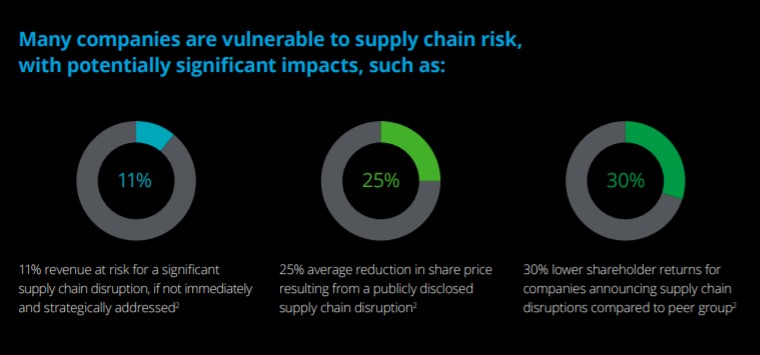- Blog
- Deliver Transportation and Logistics Safety through Automation
Deliver Transportation and Logistics Safety through Automation
Transportation and logistics businesses are feeling the pressure to keep up with supply chain risk and potential fraud. In order to compete with the increasing demand from e-commerce channels and meet customer expectations, organisations need to invest in technology that allows them to become insights-driven to continuously improve the P2P process. Read how automation and intelligent technologies are key to doing so in this blog.
Risk. It’s a four-lettered word that has become even more important given today’s climate. As businesses, we spend a lot of our time mitigating risk to the best of our abilities, keeping company information secure, and implementing thorough visibility through processes so nothing goes overlooked.
And when it comes to modern transportation and logistics businesses, the good old rules of risk and supply chain management are still valid, but the stakes are higher than ever as more and more, digital processes are becoming the norm when it comes to streamlining and strengthening risk management and decreasing the chance of fraud.
Fraud in transportation and logistics
All logistics companies understand the gravity of fraud. Companies spend countless hours, time, and resources negating the effects of supply chain fraud and risk.
The negative effects of fraud can sometimes be more prevalent if your organisation faces any of the following:
-
The increasing volatility of the market
-
Ebbing availability of resources
-
Growing demand for transparency and social/ethical responsibility
-
Data complexity and increased data security mandates
And given the state of modern business, almost all companies are likely facing these situations.
But, out of all these, much of the fraudulent activity can be contributed to a lack of transparency and traceability within the supply chain. The thing about fraud is that it grows strongest where no one can see, where no one is paying attention. So, if your company lacks visibility into all parts of your business processes, you’re only inviting the opportunity for fraud to grow and grow quickly.
For example, according to ShipChain, fraud “could occur in the procurement of raw materials, manufacturing of products, selling and distribution of products, or in reverse logistics. All of these different opportunities for fraud means that when it does happen, it can be incredibly difficult to trace it back to the source. In the end, this often leaves everyone but the culprit frustrated. As the global supply chain has grown, the demand for transparency has increased, and it is clear that handling everything manually is simply ineffective and outdated.”
Deliver supply chain risk management
When you hear “fraud,” you usually think of financial fraud automatically. But it’s not always the case. Misrepresentation of the ethical nature of goods and services and limited knowledge of the environmental impact of production can be fraudulent claims that impact the reliability of your own product. Visibility into the deepest tiers of your supply chain is essential to understanding the origin and details of the products you source and purchase.
According to Deloitte, “Disruptions to global supply chains due to COVID-19 have been heavy. Free movement and operation of people, raw material, finished goods, and factory operations have been stymied. Direct supply chains (i.e., Tier 1 vendors) have experienced challenges, and so have extended supply chain partners such as third-party and fourth-party vendors—the suppliers of suppliers.”


Transportation and logistics (T&L) companies are even more vulnerable to the dangers of supply chain risks. Their services are both high-value and high-impact as they are, at their core, outsourced operations. T&L supply chains are extremely complex with rising customer expectations for faster lead times, expanded products and services, and tailored and stringent delivery expectations.
Cerasis supports the idea that these supply chains won’t decrease in complexity anytime soon. The digital era has only increased the tendencies for them to continue to increase in complexity. They state that “As the supply chain continues to grow in complexity and regulation, the opportunities for problems and other events to impact operations negatively will consequently grow. As a result, supply chain entities need to understand how risk management and resiliency applies to both good and bad situations and how an organisation can improve supply chain risk management and resiliency processes.”
Tackle fraud and risk with automation
Automation is the answer. It brings transparency to the actions of all parties within your supply chain and while it does not prevent fraud and risk totally on its own, it does add a layer of transparency that provides increased, proactive visibility into areas where fraud and risk could be lingering. Then, supply chain leaders can use this information to identify current or potential instances.
In a recent report we created with the help of the Harvard Business Review Analytic Services (HBRAS), 779 global executives were interviewed for their thoughts and opinions on the future landscape of business. Transparency was highlighted as the key barrier standing in the way of achieving more visible finance and procurement functions. 90% of executives interviewed agreed that increased business transparency leads to better-informed decision-making across the entire organisation and 60% believe poor visibility directly leads to supply chain risk. And as many as a quarter admitted that they fail to effectively evaluate supplier business practices as a part of their risk prevention and management.
To achieve the highest level of supply chain transparency, you need the right technologies. You can’t possibly expect to keep track and keep safe all the nuances of your supply chain manually. With all the working pieces, digital, intelligent technologies are a surefire way to properly manage and identify risk and fraud.
With the right automated tools built specifically to improve supply chain visibility, your transportation and logistics company can:
1. Decrease business disruptions: Prepare for supply chain disruptions before they even happen. When your supply chain operates with a strong foundation on data analysis and open lines of communication, you decrease supply chain bottlenecks and even avoid disruptions entirely.
2. Drive your business with data: Manually updating supplier information leads to obsolete data, potential risks, and wasted time. Basware solutions deliver 100% visibility into your entire supply chain, delivering the benefits of complete supply chain data. Processing this data through Basware empowers you with the insights you need to make smart, data-based decisions that will lead to supply chain excellence.
3. Team up with the right suppliers: Your suppliers are an extension of your brand. So, it’s important to ensure you’re doing business with the right suppliers who align with you ethically, meet your price requirements, offer the right experience, can meet your orders, and are financially stable. Having the right supply chain technology can guarantee your suppliers check all those boxes.
Get more industry-specific assets
Want more on how you can make your transportation and logistics business stronger, more resilient, and streamlined? Visit our dedicated T&L webpage where you can find other blogs, a Roadmap to Business Continuity, T&L Benchmarking Report, and a factsheet.
Related
-
By Basware RepresentativeUnveiling CFO Strategies for Long-Term Value Creation – Webinar Insights
-
By Anu HämäläinenUnlocking the Power of AI in Finance: A Dive into Invoice Ingestion Revolution
-
By Christopher BlakeComplexity to Clarity: Forrester's Expert Take on AP Invoice Automation
-
By Christopher BlakeChoosing AP Excellence: Finding the Right Solutions Amid S2P Suite Challenges
-
By Basware RepresentativeUnlock the Power of Invoice Digitalization: Watch Our On-Demand Webinar Now!
-
By Basware RepresentativeAP Metrics that Matter – Webinar with Ardent Partners
-
By Sanna EklundHarnessing AI and ML to Transform AP
-
By Basware RepresentativeWhen Is The Right Time To Move To Touchless Invoice Processing

